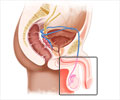- Drug resistance among bacteria can be identified with Raman spectroscopy.
- Raman spectroscopy is commonly used in chemistry to provide a structural fingerprint to help identify molecules.
- Identifying drug resistance among bacteria helps find the needed concentration of antibiotics.
The new method out of Jena provides much faster diagnosis as basis for a decision of a reliable therapy. Ute Neugebauer, who works at Leibniz-IPHT and the University Hospital Jena points to tiny electrodes that are fixed on the surface of a stamp-sized chip: "Electric fields secure bacteria in a very small area". Jena's scientists then apply various antibiotics in different concentrations on the trapped bacteria and examine them with Raman spectroscopy. "This means that we irradiate the pathogens with laser light and evaluate the scattered light spectrum", describes Neugebauer the method.
Prof. Jürgen Popp, director of the Leibniz-IPHT and head of the Institute of Physical Chemistry of the Friedrich-Schiller University Jena, explains: "After two hours we can already detect distinct changes in the Raman spectra. Out of these, we can derive whether the strain is resistant or sensible. At the same time we get information on the needed concentration of the antibiotic to constrain bacterial growth. This is an important diagnostic parameter that influences the success of a treatment decidedly", Popp continues.
The combination of fast, light-based diagnostics and a high automation level reduces the time from sampling to result from to date 72 to three and a half hours. "Such a fast procedure could revolutionize diagnostics of infectious diseases", Prof. Bettina Löffler, director of the Institute of Medical Microbiology at the University Hospital Jena, is sure about that.
Currently, researchers work at a platform for the application in hospitals. Another, more far reaching, aim is the further development into a cartridge-based rapid test system, which will enable general practitioners to identify resistances in a fast and easy way for the first time. Thereby, physicians would hold a powerful tool, from which they could benefit in personalized therapy; this means the administration of a fitting drug.
- Johanna Kirchhoff, Uwe Glaser et al. Simple Ciprofloxacin Resistance Test and Determination of Minimal Inhibitory Concentration within 2 h Using Raman Spectroscopy, Analytical Chemistry DOI: 10.1021/acs.analchem.7b03800
Source-Eurekalert














